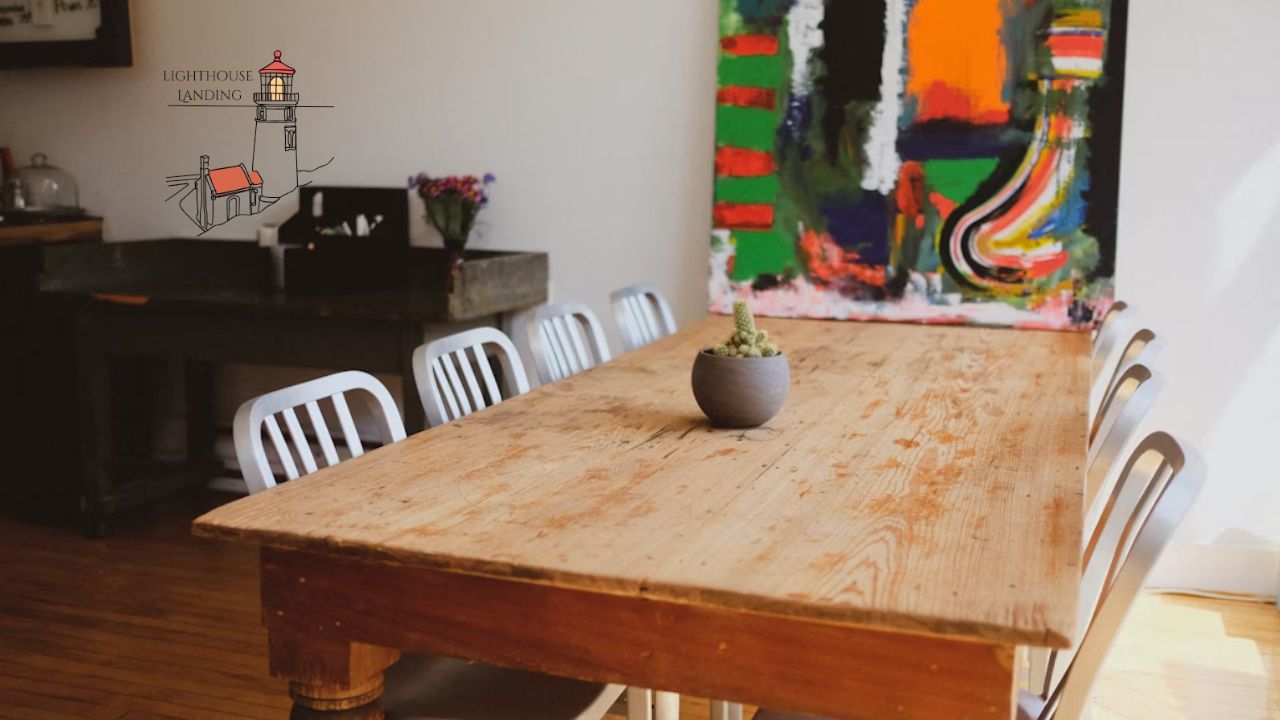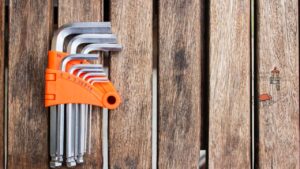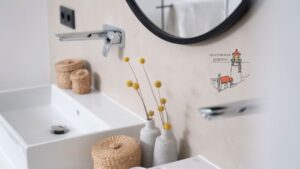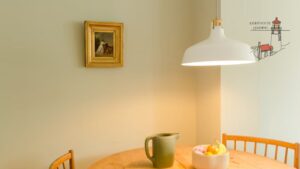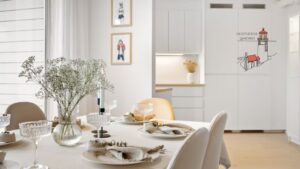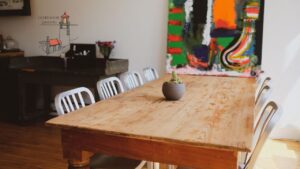A dining table is more than just furniture; it’s the heart of your home. It’s where family gathers, stories are shared, and memories are made. Choosing a solid wood dining room table is a significant investment in your home’s future, a piece that promises durability, timeless beauty, and a warmth that no other material can quite replicate. This guide will walk you through everything you need to know to find the perfect centerpiece for your dining space.
The journey to finding the right solid wood dining room table can feel overwhelming. With so many wood types, styles, and finishes, it’s easy to get lost. But don’t worry. We’re here to demystify the process, helping you make a confident choice that you’ll love for decades. Think of this as your personal consultation for finding a table that truly reflects your style and meets your family’s needs.
Quick Guide to Solid Wood Dining Tables
To get started, here’s a quick overview of some popular options. This table compares different wood types to give you a snapshot of what to expect in terms of durability, appearance, and cost.
| Wood Type | Hardness (Janka Scale) | Typical Color | Price Range | Best For |
|---|---|---|---|---|
| Oak | High (1290-1360) | Light to medium brown | $$-$$$ | High-traffic family homes |
| Walnut | Medium-High (1010) | Rich, dark brown | $$$-$$$$ | Formal dining, statement pieces |
| Maple | Very High (1450) | Creamy white to reddish-brown | $$-$$$ | Modern and minimalist styles |
| Cherry | Medium (950) | Reddish-brown, darkens with age | $$$-$$$$ | Traditional and elegant spaces |
| Pine | Low (380-420) | Light yellow or white | $-$$ | Rustic, farmhouse, budget-friendly |
| Acacia | Very High (2300) | Varies from light to dark | $$-$$$ | Unique, eclectic designs |
| Mango | Medium (1070) | Golden brown with spalting | $-$$ | Sustainable, bohemian styles |
Why a Solid Wood Dining Room Table is an Unbeatable Choice
In a world filled with veneer, particleboard, and MDF, solid wood stands apart. It’s a choice that speaks of quality, tradition, and an appreciation for natural materials. A genuine solid wood dining room table is crafted from whole pieces of wood, not engineered composites with a thin wood layer on top.
This distinction is crucial. While veneers can look appealing initially, they are prone to chipping, peeling, and water damage that can be nearly impossible to repair. A solid wood dining room table, on the other hand, is built to last a lifetime. It can be sanded down and refinished multiple times, erasing years of wear and tear and making it look brand new again. This incredible resilience is why these tables often become cherished family heirlooms, passed down through generations.
One user, Sarah from Ohio, shared her experience: “We inherited my grandmother’s oak solid wood dining room table from the 1950s. It had seen countless family dinners and had the scratches to prove it. We had it professionally refinished, and it’s absolutely stunning. It’s the centerpiece of our home now, and I love that it carries so much family history.” (Rating: 5/5 Stars)
The Emotional Connection to Wood
There’s something deeply satisfying about running your hand over a smooth, solid wood surface. Each table has a unique story told through its grain, knots, and imperfections. This organic character brings a sense of life and warmth into your dining room that mass-produced furniture simply cannot match. A solid wood dining room table is not just an object; it becomes part of your family’s narrative.
Understanding Wood Types: The Soul of Your Table
The type of wood you choose will define your table’s look, durability, and cost. Each species has its own personality. Let’s explore some of the most popular choices for a solid wood dining room table.
Hardwoods vs. Softwoods: What’s the Difference?
First, it’s helpful to understand the basic categories: hardwoods and softwoods. These terms refer to the tree’s reproduction, not necessarily the wood’s density.
- Hardwoods: Come from deciduous trees (those that lose their leaves). They are generally denser and more durable. Examples include oak, walnut, and maple.
- Softwoods: Come from coniferous trees (evergreens). They tend to be less expensive but are more susceptible to dents and scratches. Pine is a common example.
For a high-use item like a dining table, a hardwood is almost always the superior choice.
Oak: The Timeless Classic
Oak is arguably the most popular choice for a solid wood dining room table, and for good reason. It’s known for its exceptional strength and durability, making it perfect for families with active kids.
- Appearance: Oak has a prominent, beautiful grain pattern that can range from straight lines (in quarter-sawn oak) to dramatic swirls. Its color is typically a light to medium brown, which complements a wide range of decor styles.
- Durability: As a very hard wood, oak resists scratches and dents well. It’s a workhorse that can handle the daily rigors of family life.
- Styles: Its versatility makes it suitable for everything from traditional farmhouse tables to more contemporary designs. An oak solid wood dining room table is a truly adaptable piece.
Walnut: The Luxurious Statement
If you’re looking for a touch of drama and elegance, walnut is an incredible choice. It’s prized for its deep, rich colors and sophisticated grain.
- Appearance: Walnut is famous for its dark, chocolate-brown hues, often with beautiful swirls, burls, and a purplish undertone. The grain is typically straight but can be wavy, adding to its visual appeal.
- Durability: While slightly softer than oak, walnut is still a very durable hardwood that will stand the test of time.
- Styles: A walnut solid wood dining room table is often used in mid-century modern, formal, and high-end contemporary spaces. It’s a statement piece that exudes luxury.
Maple: The Modern Minimalist
Maple offers a lighter, cleaner aesthetic that is perfect for modern, Scandinavian, and minimalist interiors. Its subtle grain and bright color can make a room feel more open and airy.
- Appearance: Maple wood is typically a creamy white color with a reddish tinge. Its grain is fine and subtle, providing a smooth, uniform surface.
- Durability: Maple is one of the hardest woods available, making it incredibly resistant to dents and abuse. It’s a fantastic option for a long-lasting solid wood dining room table.
- Styles: Its clean look lends itself beautifully to sleek, modern designs. It’s also often used for butcher block-style tables.
Cherry: The Gracefully Aging Beauty
Cherry wood is beloved for the rich, reddish patina it develops over time. A new cherry table will have a lighter, pinkish-brown tone, but exposure to light will deepen it into a stunning, warm red.
- Appearance: Known for its smooth, closed grain and rich color. This aging process is considered one of its most desirable qualities.
- Durability: Cherry is a medium-hardness wood, so it can be more prone to dents than oak or maple. However, it’s still a durable choice for a solid wood dining room table.
- Styles: Often associated with traditional and formal furniture, like Queen Anne or Shaker styles.
Pine: The Rustic Charmer
As a softwood, pine is a more budget-friendly option. It’s much more susceptible to dents and scratches, but for many, this is part of its charm.
- Appearance: Pine is light in color, often with a yellowish or whitish hue and prominent knots. It distresses easily, which adds to its rustic, lived-in appeal.
- Durability: Being a softwood, it will show wear and tear. This makes it ideal for a farmhouse or cottage aesthetic where a “perfect” finish isn’t the goal.
- Styles: Perfect for rustic, farmhouse, and country-style homes. A pine solid wood dining room table offers a cozy and inviting feel.
Choosing the Right Size and Shape
Once you’ve considered the material, the next step is determining the perfect size and shape for your space and lifestyle. This is a critical decision that impacts both function and flow.
Measure Your Space (Twice!)
Before you fall in love with a specific solid wood dining room table, measure your dining area carefully. A common mistake is choosing a table that is either too large or too small for the room.
- Clearance: You need at least 36 inches (3 feet) of space on all sides of the table to allow people to sit down and walk around comfortably. If it’s a high-traffic area, aim for 48 inches.
- Visual Balance: The table shouldn’t overwhelm the room. Make sure it looks proportional to the space and other furniture. Consider mapping out the table’s dimensions on the floor with painter’s tape to visualize how it will fit.
Shape Matters: Rectangular, Round, Oval, or Square?
The shape of your solid wood dining room table affects conversation flow and how many people you can seat.
Rectangular Tables
This is the most common shape and for good reason. It works well in long, narrow rooms and can accommodate a large number of guests, especially with extendable leaves. A rectangular solid wood dining room table is a classic and versatile choice.
Round Tables
Round tables are fantastic for smaller spaces and for fostering conversation. With no head of the table, everyone feels included. They are great for square-shaped rooms and can often fit more people in a tight space compared to a square table of a similar size.
A review from Mark in California highlights this: “We switched from a square to a round solid wood dining room table in our breakfast nook, and the difference is incredible. The room feels bigger, and our family breakfasts are so much more connected.” (Rating: 5/5 Stars)
Oval Tables
Oval tables offer the best of both worlds. They provide the linear length of a rectangular table but with softened corners, which creates a better flow and feels less imposing. They are an elegant choice for rooms that are not quite large enough for a grand rectangular table.
Square Tables
Square tables are ideal for square rooms and smaller groups. They create a sense of intimacy and symmetry. However, large square tables can make it difficult for guests sitting opposite each other to converse.
Construction and Joinery: The Unseen Quality
The way a solid wood dining room table is put together is just as important as the wood it’s made from. High-quality joinery ensures the table will remain stable and strong for years to come, without wobbling or separating.
Key Joinery Techniques to Look For:
- Mortise and Tenon: A time-tested technique where a projecting piece (tenon) fits into a hole (mortise). It creates an incredibly strong and durable joint.
- Dovetail Joints: Interlocking pins and tails create a powerful bond, often seen in table legs and aprons.
- Dowels or Biscuits: These are used to reinforce joints and ensure proper alignment.
When shopping, don’t be afraid to ask the salesperson about the construction. A well-made solid wood dining room table will feature robust joinery. You can also give the table a gentle shake; it should feel solid and stable, with no give or wobble.
Style and Finish: Defining Your Table’s Personality
The style and finish of your table tie everything together. This is where you can truly express your personal taste.
Find Your Style
- Farmhouse: Often features thick, sturdy legs, a distressed finish, and a rustic feel. An oak or pine solid wood dining room table is perfect for this look.
- Modern: Characterized by clean lines, simple forms, and often lighter woods like maple or ash. The focus is on the natural beauty of the wood itself.
- Mid-Century Modern: Features organic shapes, tapered legs, and warm wood tones like walnut or teak.
- Traditional: Elegant and formal, with details like carved legs, dark finishes, and classic woods like cherry or mahogany.
- Industrial: Combines a wood top with a metal base, often made of steel or iron. This creates a striking contrast between natural and manufactured materials.
Consider the Finish
The finish protects the wood from spills, stains, and daily wear. It also enhances the wood’s natural beauty.
- Oil Finish: Penetrates the wood to create a very natural, matte look and feel. It’s easy to repair scratches but requires more frequent maintenance (re-oiling).
- Lacquer Finish: Creates a hard, durable, and often shiny protective layer on top of the wood. It’s very protective but can be difficult to repair if chipped or scratched.
- Polyurethane Finish: A plastic-based varnish that offers excellent protection against moisture and scratches. It’s a very practical choice for a family dining table.
The Perfect Pairing: Chairs and Lighting
Your dining table doesn’t exist in a vacuum. The chairs and lighting you choose are essential to creating a cohesive and functional dining space.
Choosing Dining Chairs
Don’t feel obligated to buy a matching set. Mixing and matching can add personality and visual interest.
- Comfort is Key: Make sure the chairs are comfortable to sit in for an extended period.
- Scale and Proportion: The chair height should be compatible with the table height. There should be about 10-12 inches between the seat and the tabletop.
- Style Harmony: The chairs should complement the style of your solid wood dining room table, whether through contrast or cohesion. Upholstered chairs can soften the look of a heavy wood table, while metal chairs can enhance an industrial vibe.
Illuminating Your Space: The Dining Room Light
The lighting over your dining table sets the mood. The right dining room light fixture acts as a functional piece of art.
- Placement: The fixture should be centered over the table. The bottom of the light should hang 30-36 inches above the tabletop.
- Size: The diameter of your dining room light should be about 1/2 to 2/3 the width of your table.
- Style: The style of the dining room light should complement your table and overall decor. A dramatic chandelier works well over a traditional table, while a simple pendant light might be better for a modern space.
- Dimmer Switch: Always install a dimmer switch for your dining room light. This allows you to adjust the brightness for different occasions, from bright light for homework to a soft, ambient glow for a romantic dinner. A well-chosen dining room light elevates the entire room.
Caring for Your Solid Wood Dining Room Table
A solid wood dining room table is a durable piece, but it still requires proper care to keep it looking its best.
- Regular Dusting: Use a soft, lint-free cloth.
- Cleaning Spills Immediately: Use a damp cloth and wipe dry. Do not let water sit on the surface.
- Avoid Harsh Chemicals: Cleaners with ammonia or silicone can damage the finish. A simple solution of mild soap and water is usually sufficient.
- Use Protection: Use placemats, coasters, and trivets to protect the wood from heat, moisture, and scratches.
- Control Humidity: Wood expands and contracts with changes in humidity. Try to maintain a stable environment to prevent warping or cracking.
Conclusion: An Investment for a Lifetime
Choosing a solid wood dining room table is about more than just buying furniture. It’s about investing in a piece that will anchor your home and your family life for years to come. It’s a commitment to quality, craftsmanship, and timeless style.
From the rugged strength of oak to the refined elegance of walnut, there is a perfect solid wood dining room table for every home and every story. By considering the wood type, size, construction, and style, you can confidently select a table that you will not only use but also cherish. This beautiful piece will be the backdrop for countless dinners, celebrations, and quiet morning coffees, gathering memories as beautifully as it gathers your loved ones.
Frequently Asked Questions (FAQs)
Q1: How can I tell if a dining table is truly solid wood?
A: Look at the grain pattern on the tabletop’s surface and then check the edge. On a solid wood dining room table, the grain pattern will wrap around the edge, continuing from the top. On a veneer table, you’ll often see a thin, uniform line or a repeating pattern, indicating a layer has been glued on. You can also check the underside of the table, which is often left less finished and can reveal the true nature of the wood.
Q2: Is an extendable solid wood dining room table a good idea?
A: Absolutely! Extendable tables offer fantastic flexibility. They allow you to have a smaller table for daily use, which saves space, but can easily expand to accommodate guests for holidays and dinner parties. Just make sure the extension mechanism is sturdy and easy to operate.
Q3: Can I place a hot dish directly on my solid wood table?
A: No, you should never place hot pots, pans, or dishes directly on the wood surface. The intense heat can permanently damage the finish and the wood itself, leaving a white, cloudy mark. Always use trivets or hot pads as a protective barrier.
Q4: My pine solid wood dining room table has a dent. Can I fix it?
A: Yes, small dents in softer woods like pine can often be repaired using a simple trick. Place a damp cloth over the dent and press a hot iron over it for a few seconds. The steam will cause the compressed wood fibers to swell back into place. This works best on unfinished or oil-finished wood. For deep gouges or scratches, sanding and refinishing might be necessary.
Q5: What’s the best way to choose a dining room light for my new table?
A: Consider the three S’s: Size, Shape, and Style. The dining room light fixture’s diameter should be about half to two-thirds the table’s width. The shape of the fixture should complement the table’s shape (e.g., a round chandelier over a round table or a linear fixture over a rectangular one). Finally, the style should align with your decor, whether it’s a rustic, modern, or traditional dining room light.
Admin Recommendation
Your Ultimate Guide to Grand Rivers KY Lighthouse Landing Resort
Discover Paradise at Lighthouse Landing Resort: Your Gateway to Kentucky Lake Adventures

